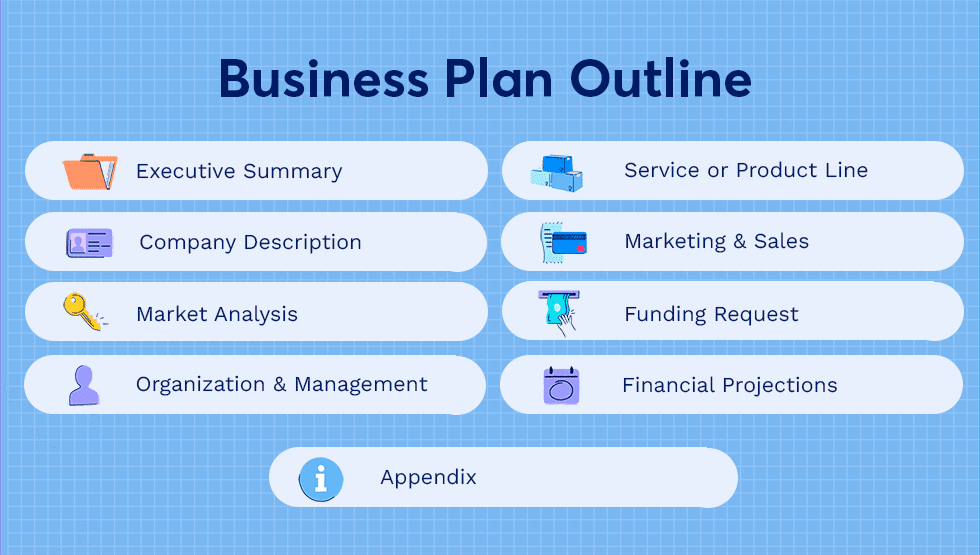A traditional business plan is a detailed document that outlines the goals and strategies of a company, including financial projections, market research, and organizational structure. A lean startup plan, on the other hand, is a more agile and iterative approach to starting a business. Instead of creating a detailed plan upfront, a lean startup focuses on rapid prototyping and testing ideas, gathering customer feedback, and making adjustments. The goal of a lean startup is to validate business assumptions as quickly as possible and to minimize the number of resources and time spent on unproven ideas. While traditional business plans can be helpful for established companies and those seeking funding from traditional sources, lean startups are more focused on quickly getting to market and learning from customer feedback.
Lean Startup
Methodology

The Lean Startup methodology emphasizes rapid prototyping, iterative product development, and data-driven decision-making to minimize waste and maximize learning in the startup process. It prioritizes creating an MVP (Minimum Viable Product) as soon as possible to test and validate the business idea, gather feedback, and learn from the market. This allows startups to quickly pivot and make changes to their business strategy as needed instead of investing a large amount of time and resources into a product that may not be successful.
The goal of the Lean Startup approach is to validate the product-market fit as early and efficiently as possible. By testing the product with potential customers and gathering feedback, the team can make informed decisions about how to iterate and improve the product before investing significant resources.
The focus on validated learning, customer feedback, and rapid iteration helps to reduce waste, minimize the risk of failure, and increase the chances of success. By testing assumptions with potential customers and continuously refining the product based on feedback, startups can quickly determine if a product is viable and pivot if necessary. The Lean Startup approach views failure as a normal and expected part of the process and values experimentation over extensive planning. The MVP is an important tool for entrepreneurs as it allows them to test their products quickly and inexpensively and receive valuable customer feedback. The approach emphasizes the importance of finding a scalable business model and being flexible in pivoting as necessary to find a successful solution.
Business Plan
A lean startup plan is a brief document that outlines the main aspects of a startup business. It includes: Problem description, a clear explanation of the problem the startup aims to solve; target audience, characteristics of the target customers that the product or service is aimed at; solution, an explanation of how the product or service solves the customer's problem; differentiation, information on what sets the product or service apart from other solutions in the market; cost, an estimate of the cost of producing the product or launching the service. The lean startup plan is usually one or two pages long and serves as a summary of a traditional business plan. It is designed to validate the business idea and determine the needs of the startup.
Traditional Business Plan
A traditional business plan is a comprehensive and detailed document that outlines the goals, strategies, and projections of a startup. It usually covers all aspects of the business, including market analysis, product/service description, target audience, organizational structure, financial projections, and implementation plan. The goal of a traditional business plan is to provide a comprehensive picture of the startup, including its strengths and weaknesses, and to convince potential investors or lenders that the company is a good investment. The plan serves as a roadmap for the company, guiding decision-making and helping to ensure that the startup stays on track. The length and complexity of traditional business plans can make them time-consuming to prepare, but they provide a thorough and well-documented plan for the startup's future.
Lean Startup vs Traditional Business Plan Outline
A lean startup plan is a concise and focused document used for quick and simple business planning. It contains elements such as value proposition, key partnerships, customer segments and relationships, revenue streams, cost structure, unfair advantage, key metrics, financial projections, and milestones. It should communicate the value of the business and outline its growth strategy.
Value proposition
A crucial element in a lean startup plan as it concisely summarizes the value that the small business brings to the market. It highlights what sets the business apart from its competitors and what benefits it offers to customers.
Key partnerships, resources, and activities
Provide information about the partners working with the business and the resources used to create value for the target audience. This includes intellectual property or capital used to gain a competitive advantage.
Customer segments, channels, and relationships
Define the target market, the methods for reaching them, and the strategies for building a lasting relationship with them. This section should identify the audience and provide insight into how the business plans to establish a strong customer experience.
Revenue streams
Explain the various ways in which the business plans to generate income. This includes a list of the revenue streams and a quick section that outlines the cost structure strategy. The cost structure is an overview of the expenses involved in running the business and how they impact the overall profitability.
Overall, a lean startup plan should be a concise and focused document that communicates the value of your business and outlines your strategy for growth.

Traditional business plans are comprehensive and detailed, covering all aspects of the business, including executive summary, business description, market and industry analysis, organization and management, financial projections, financing request, and appendix. They are usually used when the startup requires a lot of upfront investment and planning and provide a blueprint for the future of the business.
Executive summary
Provides a brief overview of the company, its products/services, target market, and goals
Business description, concept, and strategy
More in-depth information about products/services, business ideas, and overall goals/strategies with a projected timeline
Industry analysis
Analysis of competitors, their offerings, and how the company will differentiate itself
Market analysis
Definition of target audience and how the business will attract and retain them
Organization and management
Biographies and responsibilities of management/staff
Financial projections
Projection of profit and loss, income statement, expenses budget, sales forecast, and break-even analysis
Financing request
Outlines funding requested, amount, and spending plan
Appendix
Includes industry studies, legal documents, and other important information.
Lean Startup vs Traditional Business Plan
The lean startup approach contrasts with the traditional business model regarding hiring employees. While traditional businesses look for workers with specific experience and skills, lean startups prioritize those who can learn, adapt, and work efficiently. Additionally, lean startups use different financial reporting metrics, such as the cost of acquiring customers, the value of a customer over time, the rate of customer loss, and the potential for their product to spread quickly, rather than relying on traditional financial reports like income statements, balance sheets, and cash flow statements.
The Benefits
Lean Startup
A lean startup business plan offers several benefits compared to a traditional business plan. These advantages include bringing a company to market faster, greater flexibility to pivot if the original idea is not successful, and improved chances of attracting investors.
Faster Market
By prioritizing speed to market, businesses utilizing a lean startup plan can quickly establish a presence in a highly competitive industry.
Flexible
The streamlined nature of a lean startup plan means that if the original idea proves unviable, businesses can abandon it without having invested significant time and resources in creating a traditional business plan.
Attractive
Lean startup plans tend to be more concise and easier to understand, making them more appealing to potential investors.
Traditional Business
A traditional business plan has several advantages, including reduced risk, easier access to external financing, and better presentation of large, expensive, and exclusive products.
Reduced Risk
The process of creating a traditional business plan helps eliminate the risk of launching a product too quickly, as seen in the lean startup methodology.
Easier Access to External Financing
Financial institutions such as banks are more inclined to grant loans to businesses that have a well-structured business plan, making it easier to acquire external financing.
Better Presentation of Large, Expensive, and Exclusive Products
A traditional business plan is more effective in presenting larger, more expensive, and exclusive products, where creating multiple MVP versions may not be feasible due to cost considerations.
The Disadvantages
Lean Startup
There are several potential disadvantages of the lean startup approach:
Limited planning
Because the focus is on rapid prototyping and testing, there may be less emphasis on long-term planning and strategic thinking. This can make it difficult to create a sustainable and scalable business.
Limited resources
The lean startup approach may require a less initial investment, but it also means that resources are more limited. This can make it difficult to execute larger and more complex projects.
Lack of structure
Without a detailed business plan, it can be harder to create a clear roadmap for the business and to communicate that plan to others. This can make it difficult to attract investment, partners, or employees.
Difficulty in forecasting
The lean startup approach may make it difficult to forecast future performance and revenue, which can be a challenge when trying to secure funding or make other important business decisions.
Risk of pivoting too much
The lean startup approach encourages experimentation and iteration, but too much pivoting can lead to confusion and a lack of direction for the startup.
Limited customer validation
A lean startup approach may not provide full validation of the product or service from the customer, as it is focused on rapid prototyping rather than deep research of the customer's needs.
Traditional Business Plan
There are several potential disadvantages of the traditional business plan approach:
Time-consuming and costly
Creating a detailed business plan can be a time-consuming and costly process, requiring significant resources and expertise. This can be a significant barrier for entrepreneurs and small businesses.
Inflexible
A traditional business plan is often a static document that is not easily adaptable to changing circumstances. This can make it difficult to respond to unexpected events or opportunities.
Limited focus on customer validation
Traditional business plans often rely heavily on market research and financial projections, which can make it difficult to validate business assumptions with real customers.
Risk of becoming outdated
Business plans are created at a specific moment in time, and the market and the environment can change rapidly. A business plan that is too detailed and doesn't consider the dynamic nature of the market can quickly become outdated.
Limited room for experimentation
Traditional business plans are often seen as a blueprint for success, which can make it difficult to deviate from the plan or try new things.
Limited focus on execution
Traditional business plans can be heavy on strategy and light on execution, which can make it hard to move from planning to action.
Over-reliance on financial projections
Traditional business plans often rely heavily on financial projections, but these are uncertain and can be unrealistic, which can create false expectations for the company and its stakeholders.
Which Better?
The traditional business plan is more comprehensive and in-depth, covering all aspects of the business, including market research, marketing strategies, and financial projections. Lean startup plans are more focused on a minimum viable product, rapid prototyping, and iterative development.
Ultimately, the choice between the two will depend on the individual needs of the startup. If the business requires a lot of upfront investment and planning, a traditional business plan may be more appropriate. On the other hand, if the startup is trying to validate a concept quickly and cost-effectively, a lean startup approach may be more suitable.
Conclusion
Traditional business plans and lean startup plans are two different approaches to starting a business. Traditional business plans are more detailed and comprehensive, focusing on financial projections, market research, and organizational structure. They are often used by established companies and those seeking funding from traditional sources. Lean startup plans, on the other hand, are more agile and iterative, with a focus on rapid prototyping and testing ideas, gathering feedback from customers, and making adjustments as needed. The goal of a lean startup is to validate business assumptions as quickly as possible and minimize the resources and time spent on unproven ideas. Both approaches have their own advantages and disadvantages, and the right approach will depend on the specific needs and goals of the business.
References






